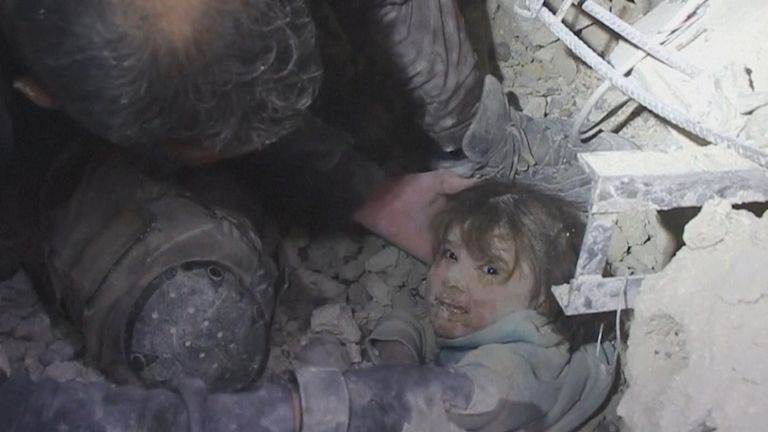A collapsed building is a “hostile and horrible” place to be trapped, says retired firefighter Rob Davis.
People who are currently buried alive under the rubble in Turkey and Syria will experience traumatic injuries, hunger, thirst, sub-zero temperatures, dust that makes it difficult to breathe, risk of fire from damaged gas lines or drowning in water from burst water lines .
It’s Mr. Davis’s job to get them out.
The 52-year-old will travel to Turkey today with other members of SARAID, Search and Rescue Assistance in Disasters.
In his 20 years with SARAID, he has seen his share of disasters: the 2004 Boxing Day tsunami in Sri Lanka, the 2010 and 2021 earthquakes in Haiti, the 2020 Beirut explosion, floods in Mozambique in 2000 and the earthquake in Pakistan in 2005.
For people who have not witnessed these types of natural disasters, the scale is a “horrible” shock, Mr Davis told Sky News.
“You’re literally driving on roads and buildings have just been demolished. You see the impact that has on survivors who are completely in shock, scared, don’t know what to do next.”
Over 5,200 dead – live updates after Turkey-Syria earthquake
reach the trap
The scale of the devastation in Turkey and Syria is enormous. The World Health Organization estimates that 23 million people have been affected and believe deaths could rise to more than 20,000.
This makes coordination an important part of the job. SARAID will coordinate other international search and rescue teams and conduct building assessments, examining what the building was used for at the time of the earthquake, how many people would have been inside, what damage was caused and the likelihood of people being alive.
Teams prioritize buildings where there were a lot of people at the time of the earthquake, such as hospitals.
Then the search begins. Teams will use search dogs, sensitive sound-tracking equipment, camera systems that look into gaps, drone and ground penetrating radar – as well as their eyes and ears.
Mr Davis said they had had ‘surprising’ success ‘just by using your own senses on a building’.
“In Pakistan, we rescued an elderly man by simply calling for complete silence and listening, and found this man tapping under the rubble.”
Rescuers will drill a pilot hole to locate trapped people, then use drills, disc cutters and heavy breaching equipment to break through the concrete in a controlled manner, Davis said. Once the victim is evacuated, he is handed over to the medical team for evaluation and treatment.
The “window of survival”
Chances of survival decrease over time, with a number of factors affecting people’s chances.
“Is the person traumatized? This will have an impact on the survival time. Is the void in which it finds itself stable? Will the aftershock cause more collapse and subsequently more injury?
“The weather conditions are huge – it’s very cold, hypothermia is going to set in for some of these people. Lack of water, food.
“It’s the rule of three, isn’t it? Three [minutes] for lack of oxygen, three days for lack of water and 30 days for lack of food.”
Learn more:
Anger and frustration when looking for trapped relatives
What is an aftershock – and why are massive landslides now likely?
WHO warns death toll could rise to over 20,000
The “survival window” is normally five to 10 days, Davis said. It will be up to the national emergency management agency – in this case the Turkish government – to determine when the search and rescue phase will end.
Once this is over, the teams can then be called upon to work to recover the dead and repatriate them to their families.
The mother “just wanted to get her children back”
The decisions they have to make about who should get help can be difficult to communicate.
Mr Davis recalls a moving scene in Pakistan in 2005: “One afternoon I had a young mum punching my chest and saying her children were trapped under the building, would we rescue them? And through the interpreter, I had to ask a very difficult question, which was ‘I’m so sorry to hear this, but are your children alive or dead?’
“And she said, ‘they’re alive, I can hear them’, so we asked her to drive us to the building. When we got there, the kids were dead.
“She just wanted her kids back, and I didn’t blame her.
“We get that with every major deployment. Sometimes we have to be very sensitive, but strong enough and just say, ‘I’m sorry, I’m not here right now picking up dead bodies. I’m here to try and find people who are alive.'”
Working in “horrible” conditions
Lifeguards will work in incredibly difficult conditions. After the 2010 earthquake in Haiti, Mr. Davis spent 15 hours working on a completely destroyed school. They searched for survivors surrounded by the bodies of around 50 children between the ages of 5 and 11.
“People were killed en masse under these buildings and of course they are still there. Horrible as it sounds, they are starting to decay.
“The smell of death was pretty awful.”
The SARAID team will arrive in Turkey two days after the earthquake, with some of the 76 specialists, four search dogs and rescue equipment being sent by the British government.
It’s likely there will be rescues next week, Mr Davis said, and they will be working “around the clock”.
“If there are people to be found, we will find them with the skills and equipment we have,” he said.




